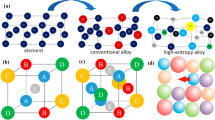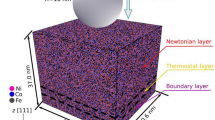The effect of aging at room temperature after equal-channel angular pressing and annealing on parameters of the low-temperature relaxation peak and dynamic Young’s modulus in nanostructured copper is studied. The dislocation nature of the peak is established. It is shown that the high rate of change for all peak parameters is observed close to the copper static relaxation temperature. The data obtained are in good agreement with results of high-temperature in situ changes of elasticity modulus and microhardness.



Similar content being viewed by others
References
R. Z. Valiev and T. G. Langdon, “Principles of equal-channel angular pressing as a processing tool for grain refinement,” Prog. Mater. Sci., 51, 881–891 (2006).
N. Kobelev, E. Kolyvanov, and Y. Estrin, “Temperature dependence of sound attenuation and shear modulus of ultra fine grained copper produced by equal channel angular pressing,” Acta Mater., 56, 1473–1481 (2008).
V. D. Natsik, P. P. Pal’-Val’, and S. N. Smirnov, “Composite piezoelectric vibrator theory,” Akust. Zh., 44(5), 640–647 (1998).
I. I. Novikov, Metal Heat Treatment Theory [in Russian], Metallurgiya, Moscow (1986).
D. Niblett and J. Wickes, “Internal friction in metals connected with dislocations,” Usp. Fiz. Nauk, 80(1), 125–187 (1963).
A. Zeger and P. Shiller, “Kinks at dislocations and their effect on internal friction in crystals,” in: U. Mason (ed.), Physical Acoustics [Russian translation], Mir, Moscow (1969), Vol. 3, Part A, pp. 428–573.
A. Novik and B. Berry, Relaxation Phenomena in Crystals [in Russian], Atomizdat, Moscow (1975).
V. S. Postnikov, Internal Friction in Metals [in Russian], Metallurgiya, Moscow (1974).
I. S. Golovin, “Grain-boundary relaxation in copper before and after equal channel angular pressing and recrystallization,” Fiz. Met. Metalloved., 110(4), 424–432 (2010).
I. S. Golovin and Y. Estrin, “Mechanical spectroscopy of ultra-fine grained copper,” Mat. Sci. Forum., 667–669, 857–862 (2011).
R. J. Hellmig, M. Janecek, B. Hadzima, et al., “ A portrait of copper processed by equal channel angular pressing,” Mater. Trans., 49(1), 31–37 (2008).
Author information
Authors and Affiliations
Corresponding author
Additional information
Translated from Metallovedenie i Termicheskaya Obrabotka Metallov, No. 5, pp. 28 – 32, May, 2012.
Rights and permissions
About this article
Cite this article
Pal’-Val’, P.P., Pal’-Val’, L.N. Low-temperature internal friction and nanostructured metal stability. Met Sci Heat Treat 54, 234–238 (2012). https://doi.org/10.1007/s11041-012-9488-1
Published:
Issue Date:
DOI: https://doi.org/10.1007/s11041-012-9488-1




